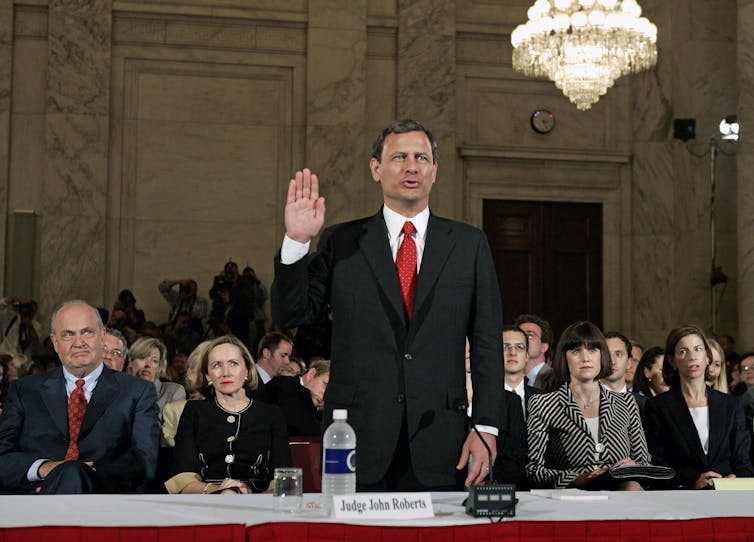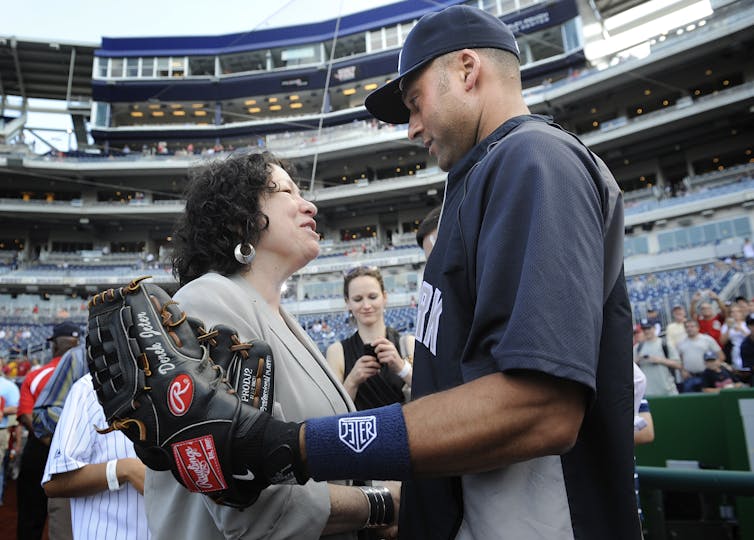Kavanaugh's 'judge as umpire' metaphor sounds neutral but it's deeply conservative
- Written by William Blake, Assistant Professor of Political Science, University of Maryland, Baltimore County
Supreme Court nominee Judge Brett Kavanaugh invoked baseball to explain his judicial philosophy at his confirmation hearing.
“A good judge,” he said in his opening statement to the Senate Judiciary Committee on Sept. 4[1], “must be an umpire – a neutral and impartial arbiter who favors no litigant or policy.”
This is not the first time a Supreme Court nominee has employed the judge-as-umpire analogy. Chief Justice John Roberts[2] told senators at his 2005 confirmation hearing, “Umpires don’t make the rules; they apply them. The role of an umpire and a judge is critical. … But it is a limited role.”
The reference to America’s national pastime may sound politically neutral, but it is not.
As a scholar of judicial decision-making[3], I recognize that this analogy reflects the conservatism of Kavanaugh’s and Roberts’ judicial philosophies.
Originalism - getting the call right?
Conservative jurists and legal scholars believe that judges must interpret the Constitution according to its framers’ original understanding[4], just as umpires must call a strike on any pitch in the strike zone. There is only one answer, grounded in observable facts.
This judicial philosophy – called “originalism[5]” – says that if judges spend enough time studying the facts of a case and American history, they will find the one correct response to a constitutional dispute.
 Chief Justice John Roberts has also invoked baseball umpires when describing his vision of a good judge.
Reuters/Jason Reed[6]
Chief Justice John Roberts has also invoked baseball umpires when describing his vision of a good judge.
Reuters/Jason Reed[6]
In a 2016 speech[7] titled “The Judge as Umpire: Ten Principles,” Kavanaugh extolled the virtues of rule-following and consistency in law and sports.Aspiring umpires in training schools spend dozens of classroom hours[8] poring over the baseball rule book[9]. To apply their knowledge, they do drills on the field, practicing their footwork and learning how to react to different situations.
They strive for military precision so that strikes and outs are called correctly every time, just as the baseball commissioner intended when writing down the rules.
Originalists similarly believe that judges must interpret the Constitution precisely as the Founding Fathers did. To ignore the framers’ intention, they say[10], would effectively be rewriting the rules in the middle of the game.
Subjectivity in the law
Judge Kavanaugh is a Washington Nationals[11] season ticket holder. If confirmed, he would join several other die-hard baseball fans – including the conservative Justice Samuel Alito[12] and Justice Sonia Sotomayor[13], an Obama appointee – on the Supreme Court.
But if these three justices umpired a baseball game, conservatives Alito and Kavanaugh might make some calls differently than Sotomayor.
Liberal justices think judges will disagree about how to solve legal questions, based on each judge’s worldview. Advocates of this “living Constitution[14]” theory think it is healthy for the 250-year-old Constitution to be reinterpreted as American society – and the needs of its citizens – change over time.
In speeches before she joined the Supreme Court, Justice Sotomayor explained that a judge’s particular life experiences as a “Latina woman,” say, or a “white male”[15] bring important intellectual diversity to the bench.
Sotomayor clarified in her 2009 Senate confirmation[16] that she was not arguing that judges are or should be partisan. Rather, she believes that objectivity is an aspiration no judge can fully achieve because the law itself is not neutral.
The court’s jurisprudence on abortion, for example, affects women differently than men.
 Sotomayor is a big Yankees fan, but she has never suggested that the law is like baseball.
Reuters/Jonathan Ernst[17]
Sotomayor is a big Yankees fan, but she has never suggested that the law is like baseball.
Reuters/Jonathan Ernst[17]
What if the rules aren’t clear?
Umpires, too, have acknowledged their job is also somewhat subjective.
They strive for consistency in their calls. But as the 24-year Major League Baseball veteran Gary Cederstrom[18] once said in refuting the comparison between baseball and originalism, some umpires may create a strike zone that is slightly larger or tighter than the rule book’s standard[19].
Officially, the strike zone goes from roughly the batter’s knees to the letters on his jersey. Cederstrom says flexibility in applying that rule is appropriate because each umpire has a slightly different view of what pitch a batter can reasonably hit.
The strike zone is “like the Constitution,” he said – “a living, breathing document.”
The baseball rule book[20] even uses phrases like “in the umpire’s judgment” over 80 times, by my count.
And its contents are sometimes incomplete or indeterminate. Take the very first rule, 1.01, which states that, “Baseball is a game between two teams of nine players each.”
Baseball fans know that in the American League, but not the National League, a designated hitter[21] may bat for the pitcher. Isn’t he a 10th player?
Recapping the final score
Neither umpiring nor judging seems to me to be a wholly objective enterprise.
But I don’t want to take Kavanaugh’s sports analogy too far, because ultimately it glosses over significant differences between the Constitution and the rules of baseball.
As University of California, Berkeley law professor Erwin Chemerinksy[22] wrote in a recent Los Angeles Times opinion piece, “The Constitution was written – intentionally – in broad, open-ended language that rarely provides guidance for issues that must be resolved by the Supreme Court.”
Most Americans are aligned with Chemerinksy’s view.
Polling[23] shows that, on average, 52 percent of people believe the Constitution should be interpreted in light of “changing times and current realities.” Just 42 percent believe, like Kavanaugh, that “the Supreme Court should only consider the original intentions of the authors of the Constitution.”
The “judges-as-umpires” analogy is unlikely to change their minds.
According to research by political scientist James Gibson of Washington University in St. Louis[24], people generally believe judges try to be as impartial as possible while making decisions that are ultimately subjective.
As evidence, residents of states with elected judges do not lose faith[25] in the courts, even when judicial candidates tell voters where they stand on controversial issues like abortion.
Kavanaugh tried to transform abstract debates about legal theory into the more familiar context of sports. But ultimately his baseball metaphor reveals less about American justice than it does about his own judicial conservatism.
References
- ^ he said in his opening statement to the Senate Judiciary Committee on Sept. 4 (www.nytimes.com)
- ^ Chief Justice John Roberts (www.nytimes.com)
- ^ judicial decision-making (www.cambridge.org)
- ^ original understanding (www.npr.org)
- ^ originalism (www.ncronline.org)
- ^ Reuters/Jason Reed (pictures.reuters.com)
- ^ speech (scholarship.law.edu)
- ^ classroom hours (www.umpireschool.com)
- ^ baseball rule book (mlb.mlb.com)
- ^ they say (www.washingtonpost.com)
- ^ Washington Nationals (www.washingtonpost.com)
- ^ Justice Samuel Alito (www.mlb.com)
- ^ Justice Sonia Sotomayor (thelegalintelligencer.typepad.com)
- ^ living Constitution (www.law.uchicago.edu)
- ^ as a “Latina woman,” say, or a “white male” (www.cnn.com)
- ^ confirmation (www.cbsnews.com)
- ^ Reuters/Jonathan Ernst (pictures.reuters.com)
- ^ Gary Cederstrom (www.nytimes.com)
- ^ rule book’s standard (m.mlb.com)
- ^ rule book (mlb.mlb.com)
- ^ designated hitter (m.mlb.com)
- ^ University of California, Berkeley law professor Erwin Chemerinksy (www.latimes.com)
- ^ Polling (papers.ssrn.com)
- ^ James Gibson of Washington University in St. Louis (www.press.uchicago.edu)
- ^ do not lose faith (books.google.com)
Authors: William Blake, Assistant Professor of Political Science, University of Maryland, Baltimore County


